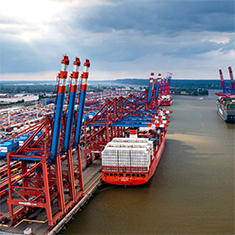
Ports and harbors stand at the forefront of climate resiliency challenges, grappling with rising sea levels, intensifying storms and evolving regulatory demands. These forces are reshaping how coastal infrastructure is designed, maintained and modernized to ensure long-term functionality and sustainability. Meeting these challenges requires a thoughtful balance of innovation, strategic planning and deep technical expertise.
In this Q&A, Andy Raichle, executive vice president of marine engineering and climate resiliency at Bowman, draws on more than three decades of experience to explore how the industry is adapting. Raichle discusses the critical issues facing ports today, Bowman’s forward-looking strategies for resilient infrastructure and the advanced tools helping clients navigate an ever-changing coastal environment.
Q: What challenges are ports and harbors facing today in terms of climate resiliency?
A: Port operations are particularly vulnerable to the realities of climate change. The impacts of sea level rise and the increased frequency and intensity of storms are significant problems that demand ports’ attention and investment if the U.S. port network is to remain viable. However, in the short term, the biggest challenge ports face may actually be politics.
In the 2020s, ports have made substantial efforts, backed by federal funding, to decarbonize their operations and support renewable energy infrastructure, including investments in port facilities dedicated to offshore wind development. As the federal political power structure has changed, the trajectory of those initiatives has become uncertain, and fossil fuel investments will likely be prioritized.
Ports will struggle with decisions on what to invest in. Should they prioritize LNG export or offshore wind development? Invest in decarbonization of port operations or double down on traditional fuel-powered equipment? These challenges will be at the forefront of port planning in 2025.
Q: What trends are shaping the future of the ports and harbors market, and how is Bowman positioning itself to lead in this space?
A: Bowman’s 2022 acquisition and integration of former Anchor Consultants firmly established our presence in the ports and harbors market, granting us immediate credibility within the marine engineering community. Our 2024 investments in senior leadership roles focused on port planning, operations and coastal resiliency have further strengthened our position in this evolving sector. With these assets and experience in place, Bowman addresses a critical “mid-market” gap that exists in the ports and harbors consulting arena, appealing to clients eager for a new player in the field. We are actively pursuing market trends such as capacity (throughput) expansion, resiliency and sustainability, infrastructure modernization and operational efficiency.
Q: What are the key strategies Bowman employs to harden port infrastructure against extreme weather and flooding?
A: Resiliency is fundamentally about the ability to recover from adversity, and we are often tasked with determining the “right” level of protection. Too much protection can hinder port operations—for example, raising a dock too high to efficiently service berthed ships—while being unnecessarily expensive. On the other hand, insufficient protection can disrupt operations for just a few days, but with enormous economic and supply chain costs.
With these factors in mind, we prioritize benefit-to-cost evaluations for every piece of resilient infrastructure we develop. The technologies we use are proven and include robust stormwater systems, elevation or hardening of critical infrastructure and nature-based solutions, all of which Bowman regularly implements across the country. These tools are deployed thoughtfully and strategically to ensure the right balance between resilience and functionality.
Q: What role does technology play in Bowman’s planning and resiliency efforts for ports and harbors?
A: Effective climate change planning begins with a clear understanding of asset vulnerability, yet port operators and owners often lack detailed insight into the condition of their infrastructure. Bowman has addressed this gap with the development of the PACK (Port Assessment and Conditions Kit), a geospatial tool built on comprehensive above- and below-water survey data collected by our marine surveying team. Using vessel-based multi-beam and lidar technology, we gather data that captures all elements of marine structures.
This information is then compiled into detailed maps that serve as base layers for geo-located engineering evaluations of structural components such as piles, superstructures and water depths. These evaluations are catalogued in a GIS format for easy access and long-term usability. The PACK tool is specifically designed to address inefficiencies in port asset management, providing a lasting data repository that supports maintenance, resilience planning and climate adaptation efforts.
Q: What long-term impacts does Bowman foresee for ports adapting to climate change, and how can they stay ahead of the curve?
A: Adapting ports to climate change will need to happen incrementally. The nature of the ship-to-shore interaction limits how much upland facilities can be elevated without making stevedoring inefficient. As a result, gradual increases in elevation are the standard approach. However, hardening and elevating critical assets, such as electrical substations and generators, are both feasible and integral to most ports’ strategic plans. Addressing stormwater management to handle more severe rain events is also a familiar challenge for Bowman, one we routinely tackle across the country.
The most exciting and challenging efforts at ports involve climate change mitigation. Ports and shipping are significant contributors to greenhouse gas emissions, and ports globally are working to develop infrastructure that enables ships to electrify while at berth, utilize or produce renewable energy and reduce their overall carbon footprint. As these efforts gain momentum, Bowman’s extensive experience in renewable energy provides a key asset for our ports and harbors team to support these critical advancements.
About Andy Raichle
Andy Raichle is a civil and marine engineer with over 30 years of experience in a broad range of waterfront development and maritime projects throughout the U.S., its territories and the Caribbean. He is well-versed in the technical, political and regulatory specialties that are unique to the process of waterfront development/redevelopment; delivering projects within and adjacent to the waterfront, including ports, warehousing, resiliency, utilities, parks, shore protection and urban redevelopment projects. Andy’s breadth of work highlights his proficiency and expertise in both civil and marine engineering. Experienced with federal, state and county guidelines and processes, he comfortably interfaces with all regulatory agencies. In early 2023, Andy was appointed Commissioner of New Jersey State Tidelands Resource Council and provides stewardship for the State’s valuable tidelands resources.



